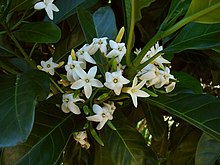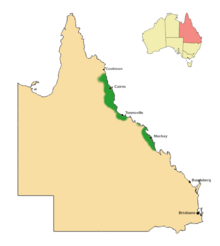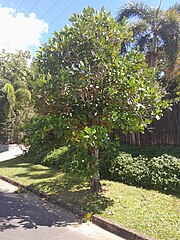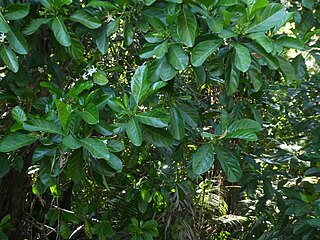| Brown gardenia | |
|---|---|

| |
| Conservation status | |
| Least Concern (NCA) | |
 Least Concern (IUCN 3.1) | |
| Scientific classification | |
| Kingdom: | Plantae |
| Clade: | Tracheophytes |
| Clade: | Angiosperms |
| Clade: | Eudicots |
| Clade: | Asterids |
| Order: | Gentianales |
| Family: | Rubiaceae |
| Genus: | Atractocarpus |
| Species: | A. fitzalanii |
| Binomial name | |
| Atractocarpus fitzalanii (F.Muell.) Puttock | |

| |
| Synonyms | |
Atractocarpus fitzalanii, commonly known as the brown gardenia or yellow mangosteen, is a species of plant in the coffee and madder family Rubiaceae. It is found in coastal parts of tropical Queensland, Australia. The beautifully scented flowers and glossy foliage has seen this plant enter cultivation in gardens of eastern Australia.
Description
The brown gardenia is a woody shrub or small tree usually growing up to 3 m (9.8 ft) wide and 8 m (26 ft) high, although it may reach up to 20 m (66 ft) on occasions, and it has a smooth grey trunk up to 35 cm (14 in) diameter. The large leaves are obovate to oval-shaped and may be up to 20 cm (7.9 in) long by 10 cm (3.9 in) wide, held on petioles up to 3 cm (1.2 in) long. They are glossy dark green above, dull grey-green below, and have an opposite arrangement. The lateral veins number 6–7 pairs and subtend an angle of 50°–70° to the midrib. The new growth is a bright lime green in colour.
This species is dioecious, meaning that male and female flowers are borne on separate plants. The inflorescences are panicles produced either terminally or in the leaf axils; male inflorescences have 15–30 flowers while female ones have up to 15 flowers. The fragrant white flowers measure about 3 cm (1.2 in) in diameter with a corolla tube about 1.5 cm (0.6 in) long.
The globose fruit is a drupe, yellow-brown in colour and measuring up to 10 cm (3.9 in) long by 9 cm (3.5 in) wide, usually produced singly or rarely in a cluster of 3-4. In the subspecies tenuipes they are paler, measure up to 3.8 cm (1.5 in) long by 3.5 cm (1.4 in) wide, and produced in clusters of 3-7. The calyx is persistent at the apex of the fruit in both subspecies.
Phenology
The subspecies fitzalanii flowers from October to February, and fruit ripen between September and March. Subspecies tenuipes flowers in October and November, while the fruit mature from May to August.
Taxonomy
This species was originally described as Gardenia fitzalanii in 1860 by the German naturalist and Victorian state botanist Ferdinand von Mueller. The description was based on plant material collected by the Irish-born botanist Eugene Fitzalan during an expedition in August–October 1860 to find the mouth of the Burdekin River.
In 1866 George Bentham transferred the species to the genus Randia, where it remained for over 130 years. In 1999 the Australian botanist Christopher Francis Puttock published a revision of Atractocarpus in Australia, in which he gave this species its current combination.
Subspecies
Two subspecies are recognised:
- Atractocarpus fitzalanii subsp. fitzalanii
- Atractocarpus fitzalanii subsp. tenuipes
Etymology
The genus name Atractocarpus is derived from the Ancient Greek terms átraktos meaning 'spindle' and karpós 'fruit', and refers to the spindle-shaped fruit of the type species. The species epithet fitzalanii was given in honour of the collector. The subspecies name tenuipes is from the Latin tenuipes meaning 'slender legged', a reference to the slender pedicels displayed by the group.
Distribution and habitat
A. f. subsp. fitzalanii is widespread in rainforest, monsoon forest, swamp forest, mangrove forest, and riparian forest from just south of Cooktown to just south of Mackay, at elevations from sea level to around 1,200 m (3,900 ft).
A. f. subsp. tenuipes is found at higher elevations from 500 to 1,500 m (1,600 to 4,900 ft) and has a more restricted range than its parent, from near Cape Tribulation to the southern Atherton Tableland.
Ecology
Moths visit the flowers soon after opening. The fruits are eaten by a variety of birds and animals, including the cassowary (Casuarius casuarius).
Cultivation
Its bushy lush foliage and bright new growth, fragrant flowers and edible and tasty fruit give it horticultural potential in gardens in subtropical climates. It is suited to a shady position with good drainage in gardens, or moderately to brightly lit indoor spaces. In the city of Cairns, more than 280 of these have been planted as street trees.
Gallery
References
- "Species profile—Atractocarpus fitzalanii". Queensland Department of Environment and Science. Queensland Government. 2022. Retrieved 7 September 2023.
- IUCN SSC Global Tree Specialist Group; Botanic Gardens Conservation International (BGCI). (2021). "Atractocarpus fitzalanii". IUCN Red List of Threatened Species. 2021: e.T192498222A192498224. doi:10.2305/IUCN.UK.2021-1.RLTS.T192498222A192498224.en. Retrieved 7 September 2023.
- "Atractocarpus fitzalanii". Australian Plant Name Index (APNI). Centre for Australian National Biodiversity Research, Australian Government. Retrieved 7 September 2023.
- ^ "Atractocarpus fitzalanii (F.Muell.) Puttock". Plants of the World Online. Royal Botanic Gardens, Kew. Retrieved 7 September 2023.
- ^ Puttock, Christopher F. (10 July 1999). "Revision of Atractocarpus (Rubiaceae: Gardenieae) in Australia and New Combinations for Some Extra-Australian Taxa". Australian Systematic Botany. 12 (2): 285. doi:10.1071/SB97030. Retrieved 8 September 2023.
- ^ F.A.Zich; B.P.M.Hyland; T.Whiffen; R.A.Kerrigan (2020). "Atractocarpus fitzalanii subsp. fitzalanii". Australian Tropical Rainforest Plants Edition 8 (RFK8). Centre for Australian National Biodiversity Research (CANBR), Australian Government. Retrieved 7 September 2023.
- ^ "Native Gardenia". Toohey Forest Environmental Education Centre. The State of Queensland (Department of Education). Retrieved 12 September 2023.
- ^ "Native gardenia, brown gardenia". Central QLD Coast Landcare Network. Retrieved 12 September 2023.
- ^ Cooper, Wendy; Cooper, William T. (June 2004). Fruits of the Australian Tropical Rainforest. Clifton Hill, Victoria, Australia: Nokomis Editions. p. 434. ISBN 9780958174213.
- ^ F.A.Zich; B.P.M.Hyland; T.Whiffen; R.A.Kerrigan (2020). "Atractocarpus fitzalanii subsp. tenuipes". Australian Tropical Rainforest Plants Edition 8 (RFK8). Centre for Australian National Biodiversity Research (CANBR), Australian Government. Retrieved 7 September 2023.
- Mueller, Ferdinand von (1860). Essay on the plants collected by Mr Eugene Fitzalan, during Lieut. Smith's expedition to the estuary of the Burdekin. Melbourne: Victorian Government. Retrieved 8 September 2023.
- Report of the proceedings of the Queensland Government schooner "Spitfire" in search of the mouth of the River Burdekin, on the north-eastern coast of Australia : and of the exploration of a portion of that coast extending from Gloucester Island to Halifax Bay., Brisbane: Queensland Government, 1860, nla.obj-475664242, retrieved 8 September 2023 – via Trove
- Bentham, George; Mueller, Ferdinand von (1866). Flora australiensis: a description of the plants of the Australian territory. London: L. Reeve and Co. p. 411. Retrieved 8 September 2023.
- Ratcliffe, David & Patricia (1987). Australian Native Plants for Indoors. Crows Nest, NSW: Little Hills Press. p. 125. ISBN 0-949773-49-2.
- "TreePlotter". Cairns Regional Council’s Street and Park Tree Database. Retrieved 18 September 2023.
External links
- View a map of historical sightings of this species at the Australasian Virtual Herbarium
- View observations of this species on iNaturalist
- View images of this species on Flickriver
| Taxon identifiers | |
|---|---|
| Atractocarpus fitzalanii |
|
| Gardenia fitzalanii | |




